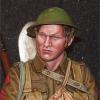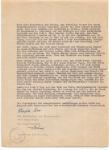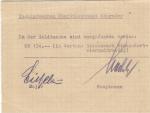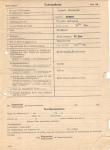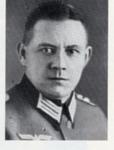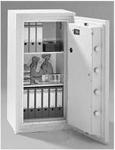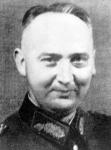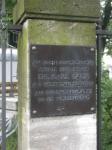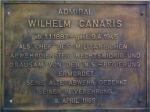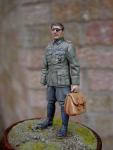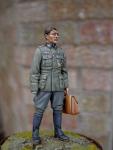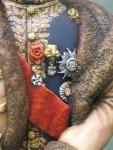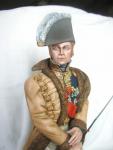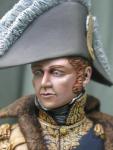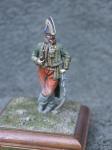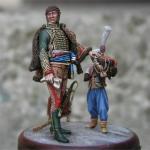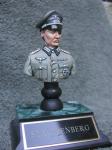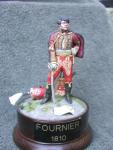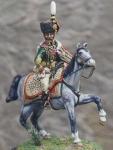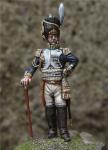I have several documents (around 50) from the estate of Abwehr Oberstleutnant Werner Schrader. As a result, I have put together a longer bio of Schrader.
Although lesser known in history than many of the other participants in the German resistance movement, Werner Schrader was one of the earliest conspirators. He actively resisted the Nazis from Hitler's 1933 accession to power until 1944, when he felt compelled to commit suicide in his quarters. As a key resister, Schrader was intimately involved with several of the most prominent conspirators. And he played a pivotal role in several of the most critical events in the history of the German resistance.
Schrader was born on March 7th, 1895 in Rottorf, Germany. He initially trained as a teacher. In 1914, he enlisted in the German army as a volunteer officer and he served throughout the Great War. Demobilized in 1920 with the rank of Oberleutnant, Schrader returned to his teaching career. Between January 1924 and March 1927, he taught history and German at an army technical school in Wolfenbuettel. He also found time to heavily involve himself in the leadership of the Stahlhelm (literally "Steel Helmet"), a nationalistic veterans' organisation politically active in the 1920's and early 30's. In 1927, he rose in the Stahlhelm to a national leadership position as Landesfuehrer or regional leader for Brunswick.
Very early on, Schrader ran afoul of the National Socialist Party. He was a leader in opposing the various conservative parties' support for Hitler and he resisted pressures to align the Stahlhelm with Hitler's storm troops, the Sturmabteilung or SA. In October 1931, while at the Harzburg Congress and in Hitler's presence, he spoke out against the excesses of the SA. In common with many other enemies of the party, Schrader was targeted by SA bullies and, in 1933 he was interned in one of the new Concentration Camps. There is evidence that his oppositionist views were cemented by the savage beatings he endured during his time under confinement.
Schrader escaped from the Concentration Camp in 1934. After his escape, he rejoined the army as a Hauptmann, with seniority dating from May 1st of 1934. In 1936, when re-arrest looked likely, Admiral Canaris personally recruited him into the Abwehr. Schrader was probably one of the Canaris' first recruits into the military intelligence service. Throughout his tenure as leader of the Abwehr, Canaris selectively recruited anti-Nazis and Jewish officers as a strategy to save them from harassment or persecution by the authorities. Given that all appointments to the Abwehr required vetting and approval by the Gestapo, his efforts in successfully recruiting foes of the regime throughout the years of the Abwehr's existence are impressive.
In 1936, Schrader was attached to the Munich Abwehrstelle or "intelligence post," where he met Rudolf Graf von Marogna-Redwitz and other future resisters. By 1938, Schrader was an Abwehr officer assigned to the headquarters of the XVII army corps in Vienna. At this time he began to collect documentary evidence of Nazi crimes.
Following the 1938 coup debacle resulting from the Munich Agreement and the resignation of Generaloberst Ludwig Beck, the conspirators regrouped and turned to Beck's successor, Franz Halder, to lead a revolt. A coup was planned for 1939, after the Allies' declaration of war but prior to the commencement of active operations. To assist with coup planning and liaison between the Abwehr and the army, Canaris prevailed on Franz Halder to authorise the creation of an Abwehr presence under Oberquartiermeister IV (Intelligence) at the headquarters of the supreme army command (OKH) at Zossen. This new army section was set up at field post office number 12500, initially under the command of Oberstleutnant I.G. Helmuth Groscurth, the former head of Abwehr group II (sabotage). This unit was known throughout the war as the Abteilung zur besonderen Verwendung ("Special Duties Section"), a sub-unit of the Heerwesenabteilung ("Army Affairs Department"). Groscurth's small section of four officers was staffed entirely by anti-Nazis. In addition to Schrader, its members included Hauptmann Fiedler and Hasso von Etzdorf, who was seconded by Ernst von Weizsaecker from his job at the Foreign Office. One of the section's roles was to liaise between Halder, in his role as Chief of General Staff, and Oberst Oster at Abwehr headquarters in Berlin. But the section's primary task was to support those conspirators within the OKH in organizing a coup against the regime.
During his time at Abteilung z.b.v. during 1939 and 1940, Schrader worked to prepare detailed coup plans and briefings for the conspirators. Given the secret nature of these documents, he often typed the material himself. As one of the earliest advocates for assassination, Schrader also worked on options and plans for killing the Fuehrer.
Schrader left the section two months before Groscurth's own removal in November 1940. Werner Schrader was promoted to Major on September 1st, 1940, and was returned to the XVII military district and reattached to XVII Corps headquarters as one of its local Abwehr officers on September 27th. By 1941 he was back at the Heerwesenabteilung in Zossen (now under the command of Oberst Radke) where he rose to the command of its Abteilung z.b.V. and the rank of Oberstleutnant by 1944. In 1944, this small department was subordinated the Wessel von Freytag-Loringhoven's Abwehr II. Schrader remained posted to Abteilung z.b.V. until his death.
During the 1939 to 1944 period, Schrader acted as the main custodian of various resistance-related files and documents, including those that he had personally collected during his previous posting at OKH. After 1943, he was also responsible for the various documents put together with bureaucratic precision by Hans Oster and Hans von Dohnanyi. Dohnanyi, Dietrich Bonhoeffer's brother-in-law, was a lawyer who effectively acted as Oster's second in command within the Abwehr's administrative group-section Z.
This archive included a detailed recounting of the 1938 and 1939 coup plans (with conspirators' names clearly recorded); photographic and documentary evidence of SS atrocities committed in Poland; a mental assessment of Adolf Hitler intended to be used at his trial; evidence of Josef Mueller's and Dietrich Bonhoeffer's respective peace missions to the Vatican and Sweden, and many other documents. The archive was intended to provide documentation for the record, as well as historical evidence that an active resistance had existed at an early date and that it had included significant civilian participation. The resisters were aware that, without documentary evidence of early tangible resistance, the Allies would present the resistance as an opportunistic movement that had only dared or cared to act when Germany seemed likely to lose the war.
In addition to these documents, Schrader was personally selected by Admiral Canaris to act as custodian of his own diary. Canaris was careful what he wrote in his diary in 1944 onwards, once he was known to be under suspicion following the arrest of Dohnanyi and Bonhoeffer. He retained this diary in his own possession. However, his diary entries from the earlier years were more explicit in their discussion of his views on Hitler and on his own involvement in the various conspiracies. It appears that about 20 pages of compromising excerpts from the 1943 diaries were held at Zossen in Schrader's safe with the rest of the archives. Two complete copies of the 1938-1942 diaries, amounting to several thousand pages, were entrusted to Schrader.
The storage and movement of these documents is an interesting historical question. They were held at various sites at various times and they seem to have been split up or combined as necessary. The earliest material, compiled personally by Schrader, was kept at this mother's house at Gross Denkte. Later, as this material grew in volume and was absorbed into Oster and Dohnanyi's larger collection, some of the material seems to have been kept in Oster's safe in Abwehr headquarters, while most of the older documentation was at Gross Denkte, stored in metal boxes and hidden by Schrader on a farm owned by his brother-in-law, Franz Kracke. In 1942, it seems that most of the archive, excepting Canaris' diary, was moved to the vault of the Preussiche Staatsbank in Berlin where Oberst Heinz's brother-in-law was the Manager. In 1943, probably after Dohnanyi's arrest and Oster's disgrace and removal, the archive was again moved, this time to a safe in the basement of a Maybach II bunker at Camp Zeppelin in Zossen where Schrader's office was located. Also in 1943, Schrader's son Werner Wolf remembers spending two days in the family's Berlin apartment, helping his father to sift through a copy of Canaris' diary, looking for compromising entries, cutting them out and storing them in yellow paper envelopes. This expurgated copy of Canaris' diary for the period September 1st, 1939 to the close of 1943 appears to have been continually stored at Gross Denkte. Soon after Schrader shot himself on July 28th, 1944, and fearing another visit from the Gestapo, Schrader's wife, Cornelia, burned this copy along with any other remaining documents from the Oster/Dohnanyi archive that were still stored at Gross Denkte.
Werner Schrader was also heavily involved in the procurement of explosive for the conspiracy. According to the SD reports submitted by Kaltenbrunner to Bormann, he was directly involved in the procurement and delivery of the plastic explosive that Stauffenberg used at Wolfsschanze on July 20th, 1944. Several deliveries of explosive were made to the conspirators over the course of the late 1943 and early 1944. It has never been conclusively determined which was the actual explosive that found its way into von Stauffenberg's briefcase on July 20th.
The August 3rd, 1944 SD report traces the Wolfsschanze explosive to a personal delivery made by Henning von Tresckow to Claus von Stauffenberg in October 1943. This material consisted of British hexonite, likely provided to assist Russian partisans, that was probably captured in 1941. This is the material that was provided to Helmuth Stieff at his headquarters at Mauerwald in late 1943. He subsequently passed it to Major Kuhn.
Obviously it was dangerous to be found in possession of such material and the risk of discovery was high given the secure nature of the Mauerwald headquarters. Kuhn enlisted the assistance of Leutnant von Hagen and together, the two buried the bomb, fuses and various other incriminating documents in two holes near a wooden watch tower. They were spotted digging in the dark by a guard patrol of the 631stGeheime Feldpolizei. A tracker dog was loosed and the explosive was discovered - but Kuhn and Hagen escaped unrecognised.
The 631stGeheime Feldpolizei turned the explosive over to the Heerwesenabteilung to complete the investigation. Werner Schrader was put in charge of the investigation by Oberst Radke. He managed to obstruct, delay and eventually completely suppress the official investigation. The explosive material was split in two portions. One half was kept for the SD while the balance was returned to Major Kuhn and the resisters.
In June 1944, Oberst Wessel von Freytag-Loringhoven became head of Abwehr II. At he end of June Werner Schrader provided him with explosive and fuses. These were passed to Claus von Stauffenberg. In all probability, this is the material that Stauffenberg ignited on the 20th of July.
Schrader is known to have visited his mentor, Admiral Canaris, several times after the latter's removal from command of the Abwehr. On one occasion he briefed Canaris' successor, Oberst Hansen, on the SD's hostile takeover of the Abwehr. On another occasion, in early July 1944, Schrader briefed Canaris on what he knew of Stauffenberg's plans for killing Hitler and bringing down the regime. It is unclear whether Schrader had been specifically briefed or whether he was assuming that an attack was imminent given his June role in providing the explosive material to Stauffenberg.
On July 26th, Schrader returned to Zossen with the intention of removing or destroying any compromising records stored there. Based on post-war affidavits and statements, it is possible that he intended to smuggle them to either Switzerland or to Yugoslavia. He brought with him two cars that had been specially modified with secret compartments under the floor sufficient to accommodate all of the resisters' records. They had been sued previously in ferrying the archives to the Berlin bank and to the Maybach bunker. One was driven by Herr Schatte of Angerburg and the other by Herr Waschke, an anti-Nazi mechanic friend of Schrader who had been responsible for modifying the cars with secret compartments and who had occasionally been used as a courier. The plan was aborted when the heavily guarded Zossen complex was locked down soon after Schrader's return, probably as a result of the suicides of General Eduard Wagner and Oberst von Freytag-Loringhoven that same day. Destroying the documents was not an option as the only reasonable method would have been by fire and the volume of material was too great to destroy without drawing unwelcome attention.
At 5:30 PM on July 28th, 1944, Schrader put a pistol to his own head and pulled the trigger. He was anxious to avoid arrest and torture and was concerned that he would betray his friends if he fell into Gestapo hands, Perhaps he recalled his experiences with Nazi physical abuse from his time in the concentration camp in 1933. He left a note on the table in his quarters that said "I will not go to prison; I will not let them torture me..."
When Werner Schrader shot himself, he removed the protective umbrella from his loyal driver Kurt Kurstenhan. Kurstenhan was a member of Otto Strasser's anti-Hitler "Black Front," who was released from detention by Schrader in 1939. By all accounts he was completely loyal to his saviour and his family. Kerstenhan was involved in secretly moving the various resistance archives at various times during the war. Released after his late July interrogation Kriminalkommissar Sonderegger of the Gestapo, Kerstenhan returned to the Prinz-Albrecht-Strasse to offer information on Schrader's 1943 transfer of certain documents to a certain safe in one of the Zossen bunkers. Kerstenhan led Sonderegger to the safe. The keys were not to be found so a locksmith from the safe manufacturer was called in. Inside the safe Sonderegger found the complete Dohnanyi archive. As a direct result, the interrogation of the already-arrested Abwehr group, including Canaris, was intensified. Other names were added to the Gestapo's list of suspects including officers not previously thought to be implicated in the bomb plot including: Thomas, Nebe, Wagner, and Brauchitsch.
To make matters worse, the Zossen copy of Canaris' diary for 1939 to 1943 was found on April 4th, 1945 when General Buhle was moving his HQ into the Zossen bunker previously occupied by OKH. Buhle had no reason to suppress this find as he had been seriously wounded as he stood beside Hitler in the briefing hut on July 20th. Recognizing the importance of his find, he immediately turned it over the SD. This copy of Canaris' jottings was instrumental in Hitler's decision to order his immediate execution as well as that of the remainder of his group. The Canaris group was executed on April 9, 1945 at Flossenburg and Sachsenhausen concentration camps.
The safe pictured below is a recently installed memorial to the resistance and to the importance of the Zossen documents.


